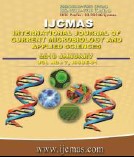


 National Academy of Agricultural Sciences (NAAS)
National Academy of Agricultural Sciences (NAAS)

|
PRINT ISSN : 2319-7692
Online ISSN : 2319-7706 Issues : 12 per year Publisher : Excellent Publishers Email : editorijcmas@gmail.com / submit@ijcmas.com Editor-in-chief: Dr.M.Prakash Index Copernicus ICV 2018: 95.39 NAAS RATING 2020: 5.38 |
Turmeric is one of the important spice crops grown in India. Root-knot nematode (Meloidogyne spp.) is a major problem, which causes galls/knots in the rhizomes and causes considerable yield loses. It also makes the way for the secondary infection by different pathogens like Pythium, Fusarium and Ralstonia in the soil. Yield losses due to nematode infestation are reported in turmeric-growing areas. A roving survey was conducted for incidence of root-knot nematode in turmeric during kharif season in 2016 at Belagavi, Bagalkot, Chamarajanagar and Kalburgi districts of Karnataka. Survey conducted in 38 villages comprising 118 fields, the major symptoms recorded during survey are having large root galls, stunted growth, yellowing, marginal and tip drying of leaves and reduced tillering with galling and rotting of roots. The results revealed that highest root-knot index was recorded in Chamarajanagara followed by belagavi, Bagalkot and Kalburgi districts. The lowest disease incidence was observed in Kalburgi.
 |
 |
 |
 |
 |